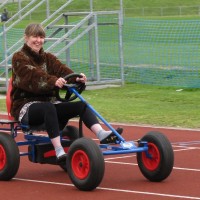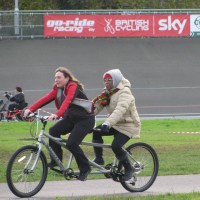Different types of cycle
There are lots of different types of cycles to suit everyone’s needs
Two-wheeled cycles
- Many disabled cyclists ride a solo bicycle with no adaptations at all.
- Some may find it easier to mount an open-frame, step through or ‘Lady’s’ bicycle with no top-tube to lift their leg over.
Folding cycles
- A small-wheeled folding bicycle will usually have an open, step-through, frame.
- The lower center of gravity may also be helpful.
- Small-wheeled cycles often have lower gearing than a full-size bicycle (because the gearing has not been adjusted to compensate fully for the smaller wheel) and this may be helpful.
- A folding bicycle has the advantage that it can easily be fitted into a car or carried on a train or bus.
Electric cycles
- There are two types of electric cycle: a Pedelec, where the rider must pedal in order to activate the motor, and an e-bike, where the motor is controlled with a switch and can be turned on when required, whether the rider is pedaling or not.
- An electric tricycle or an electric bicycle with a trailer can be powered with a car battery or similar, greatly extending the range, if the voltage is appropriate.
 Go-karts and quad bikes
Go-karts and quad bikes
- These have four wheels and are designed for fun on a track or off-road setting, rather than on the road.
- Great for balance support.
Hand Cycles
- Who needs legs to cycle? Hand Cycles enable you to pedal or ‘crank’ with your arms and provide great exercise for the upper body.
- Hand Cycles have three wheels and range from upright models with wheelchair-type seats to recumbent models with seating that is leaning back and lower to the ground.
There are hand cycles adaptations that can be fitted directly to regular wheelchairs.
- Some are built with a combined drive so the rider can use both hands and feet, there are also a variety of tandem hand cycles.
Tricycles
- Tricycles are great for balance, for cycling at a slow speed, and for regaining confidence after a break from cycling.
- They are designed with two wheels at the back and one at the front, or the reverse. Many come with a rear basket so are a great solution for transporting shopping or luggage.
- Tricycles are suitable for riding on even surfaces with few potholes.
 Tandems and tandem tricycles
Tandems and tandem tricycles
- Tandems are great for sighted and non-sighted riders to cycle and balance the tandem together.
- They can also be designed with a lower rear seat for a smaller rider, or with a smaller seat at the front which can be helpful for supervision.
- Like solo tricycles, tandem tricycles are an option if one of the partners needs balance support or is unable to put a foot down when stopping.
Trailer/Tag-a-Long cycles
- Trailer cycles attach to the seat-post of a cycle and carry a child, who can pedal to contribute to progress.
- The adult rider on the cycle has control of steering and braking. Some models come with two wheels for extra stability if the child is unable to balance.
- It is also possible to get an adaptation which lifts the front wheel of the child’s own cycle off the ground and converts it into a trailer cycle so that the adult has more control when cycling on road.
Side-by-side cycles
- These cycles are great for back support, reducing pressure on knees and hips, and sharing steering and pedalling.
- They have three wheels and riders sit next to each other, in an upright or recumbent position. They can be designed for one or both riders to pedal and steer.
- Side-by-side cycles are intended for use on a track or off-road setting.
- Available to use at Cycling for All sessions
Companion Cycles
- Companion cycles have a wheelchair or a seat for a wheelchair user, and a cycle seat for somebody to steer and pedal.
- They can be designed for a wheelchair to be clipped into a cycle frame, or carried on a cycle so that the user does not have to transfer.
- They are generally intended for use on a track or off-road setting, rather than on the road.

